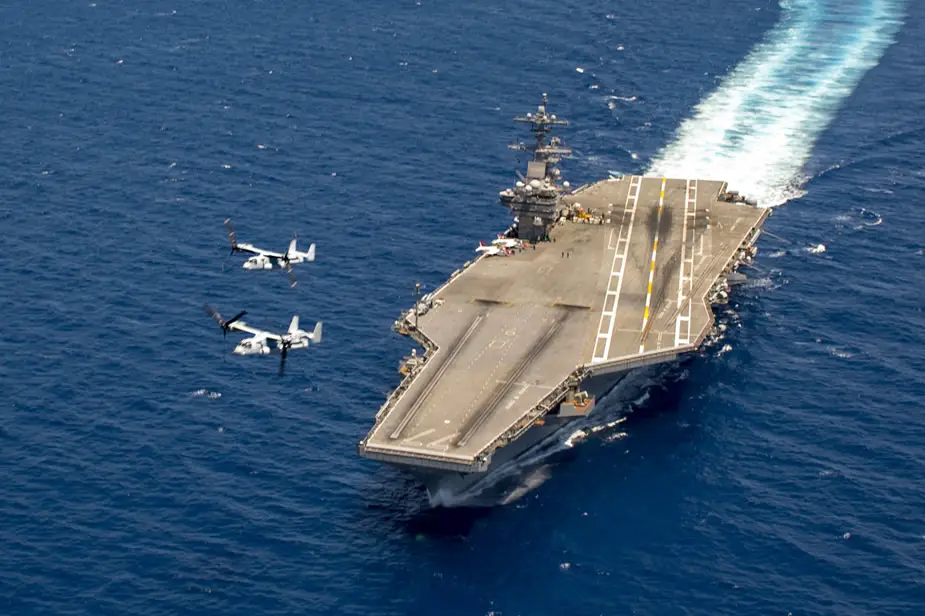Breaking news
The Future of U.S. Navy Carrier Onboard Delivery Missions.
Story by Petty Officer 3rd Class Roland John
In August 2018, MV-22 Osprey pilots successfully tested rolling landing and takeoffs in excess of 57,000 pounds on the flight deck of aircraft carrier USS George H.W. Bush (CVN 77). This key capability allows the Osprey to haul more weight than the C-2A, which is limited to landing at 49,000 pounds. GHWB’s onboard testing included integrating the MV-22 into flight deck operations, and heavy gross weight rolling landings and takeoffs.
 ATLANTIC OCEAN (Aug. 9, 2018) Two MV-22 Ospreys, attached to Air Test and Evaluation Squadron (HX) 21, fly over the aircraft carrier USS George H.W. Bush (CVN 77). The ship is underway conducting routine training exercises to maintain carrier readiness. (U.S. Navy photo by Mass Communication Specialist 3rd Class Brooke Macchietto)
ATLANTIC OCEAN (Aug. 9, 2018) Two MV-22 Ospreys, attached to Air Test and Evaluation Squadron (HX) 21, fly over the aircraft carrier USS George H.W. Bush (CVN 77). The ship is underway conducting routine training exercises to maintain carrier readiness. (U.S. Navy photo by Mass Communication Specialist 3rd Class Brooke Macchietto)
“I started off flying Greyhound carrier onboard delivery (COD) aircraft and I love the platform,” said Lt. Cmdr. Steven Tschanz, from Libertyville, Illinois, a test pilot assigned to Air Test and Evaluation Squadron (HX) 21. “With that said, nothing lasts forever and the Navy came up with a solution to move us into the future with the CMV-22 Osprey.”
The CMV-22 Osprey, the Navy’s MV-22 variant, combines fixed-wing aircraft speed and range with the vertical lift capabilities of rotary wing platforms, making it the ideal carrier strike group COD and vertical on board delivery (VOD) platform in support of aerial resupply and logistics. The Navy COD crews piloting CMV-22 aircraft will land and take off with forward airspeed, which allows flight at a much higher weight.
The Osprey has already proven its capabilities in humanitarian assistance and disaster relief, amphibious assault and medical evacuation missions. Its next evolution will use those capabilities to accomplish traditional COD missions.
“The COD community is growing,” said Tschanz. “It’s an exciting time. I think the next few years are going to be a dynamic and exciting time, not just for pilots, but also the U.S. Navy.”
Lt. Gavin Kurey, from Albuquerque, New Mexico, and also assigned to HX-21, is the first Navy pilot to land an MV-22 on an aircraft carrier.
“This underway is a historic event for the Navy,” said Kurey. “I never thought I’d be part of something like this as a COD guy. There’s a lot of reluctance to join new platforms that are so different initially, but to be part of the first wave that can help to make that transition happen is an amazing experience.”
Kurey had another first aboard GHWB in 2012 when he made his first arrested landing in a T-45 Goshawk.
The main advantage of the Osprey is its capability to take off and land vertically as a helicopter does, while requiring a much shorter runway than a Greyhound. For Osprey pilots, the chance to fly new aircraft that is on the frontline of expanding the Navy’s logistics mission is a point of pride.
“This is why I went to test pilot school,” said Tschanz. “I finished my flight with my co-pilot and we fist-bumped. This is why I joined. This is why I’m a test pilot. It’s things like this that make this job.”
Tschanz is excited this change will enhance a carrier strike group’s operational reach and expand the ability to support missions in a multitude of environments.
“To be one of the first Osprey pilots to fly aboard a carrier is just awesome,” said Tschanz. “I deployed previously aboard the George H.W. Bush for the maiden deployment in 2011, while flying the C-2 for COD missions. To come back on a totally different platform and do vertical landings is just great.”
The CMV-22 Osprey is expected to achieve Initial Operational Capability by 2021. As compared to the MV-22B, the Navy variant has extended operational range, a beyond line-of-sight HF radio, improved fuel dump capability, a public address system for passengers, and an improved lighting system for cargo loading.


























